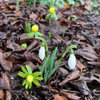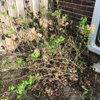Do you grow these?
woodyoak zone 5 southern Ont., Canada
10 years ago
Related Stories

FARM YOUR YARDHow to Grow Vegetables in Containers
Get glorious vegetables and fruits on your patio with a pro’s guidance — including his personal recipe for potting mix
Full Story
EDIBLE GARDENSSummer Crops: How to Grow Tomatoes
Plant tomato seedlings in spring for one of the best tastes of summer, fresh from your backyard
Full Story
GARDENING AND LANDSCAPINGGrow a Lush Privacy Screen
No need to wait forever for patio privacy the green way. These 10 ideas will get your screening up and running in no time
Full Story
FARM YOUR YARD6 Things to Know Before You Start Growing Your Own Food
It takes time and practice, but growing edibles in the suburbs or city is possible with smart prep and patience
Full Story
GARDENING GUIDESGrow Your Own Privacy: How to Screen With Plants and Trees
Use living walls to lower your home and garden's exposure while boosting natural beauty in your landscape
Full Story
SUMMER GARDENINGHow to Grow Basil
Bright color, quick growth and endless uses for cooking make this summer annual a winner in the garden or a pot
Full Story
MOST POPULARSummer Crops: How to Grow Sunflowers
Savor snack-tastic sunflower seeds once the radiant blooms have faded — if the birds have saved you any, that is
Full Story
EDIBLE GARDENSHow to Grow Your Own Sweet Summer Crops
This guide will help any gardener get started on growing the freshest warm-season veggies and berries for summer
Full Story
GARDENING GUIDESHerb Garden Essentials: Grow Your Own Delicious Mint
Pull out a pot for this one. Mint's spreading habit and hard-to-kill nature can be a blessing — if you're properly prepared
Full Story
HOUSEPLANTSHow to Grow Orchids Indoors
Orchids are the exotic aristocrats of the flower world and can make themselves comfortable in almost any home
Full Story




christinmk z5b eastern WA
woodyoak zone 5 southern Ont., CanadaOriginal Author
Related Professionals
Surprise Landscape Architects & Landscape Designers · Ballenger Creek Landscape Architects & Landscape Designers · Milwaukee Landscape Architects & Landscape Designers · San Juan Landscape Architects & Landscape Designers · Hartford Landscape Contractors · Edmond Landscape Contractors · Camp Verde Landscape Contractors · Concord Landscape Contractors · Hollywood Landscape Contractors · Morrisville Landscape Contractors · National City Landscape Contractors · Peoria Landscape Contractors · Ponte Vedra Beach Landscape Contractors · Tuscaloosa Landscape Contractors · New Carrollton Landscape ContractorsNHBabs z4b-5a NH
woodyoak zone 5 southern Ont., CanadaOriginal Author
prairiemoon2 z6b MA
woodyoak zone 5 southern Ont., CanadaOriginal Author
User
woodyoak zone 5 southern Ont., CanadaOriginal Author
User
woodyoak zone 5 southern Ont., CanadaOriginal Author
User
woodyoak zone 5 southern Ont., CanadaOriginal Author
ninamarie